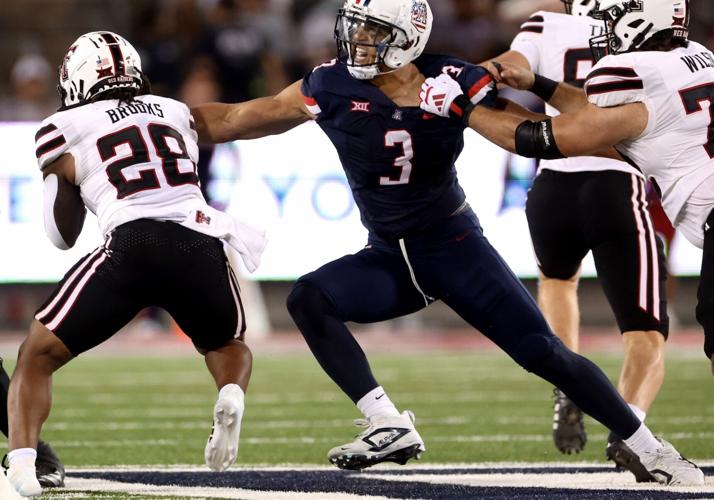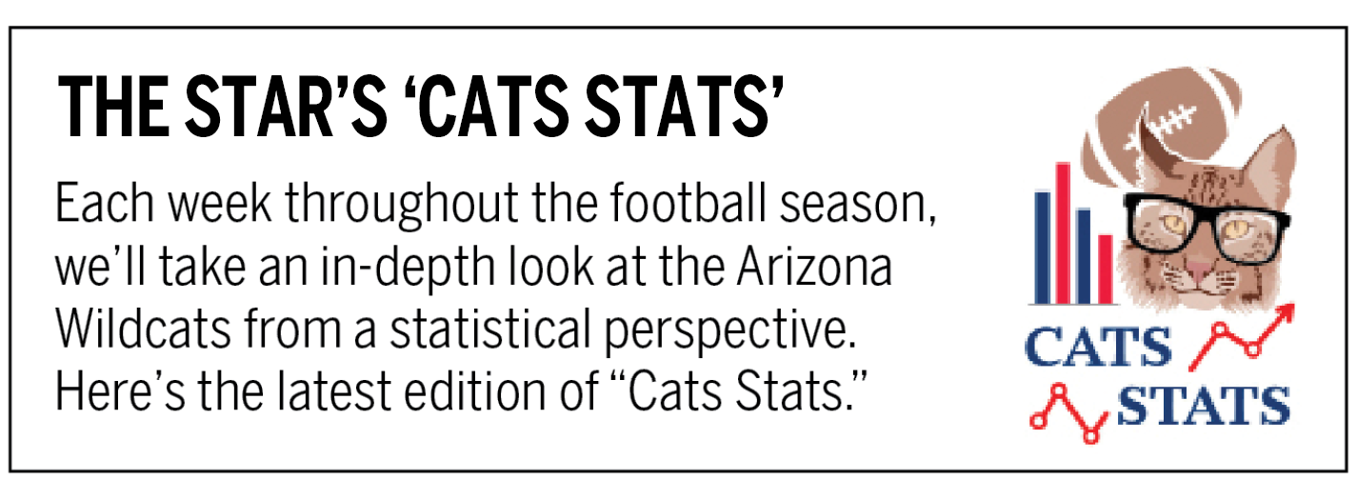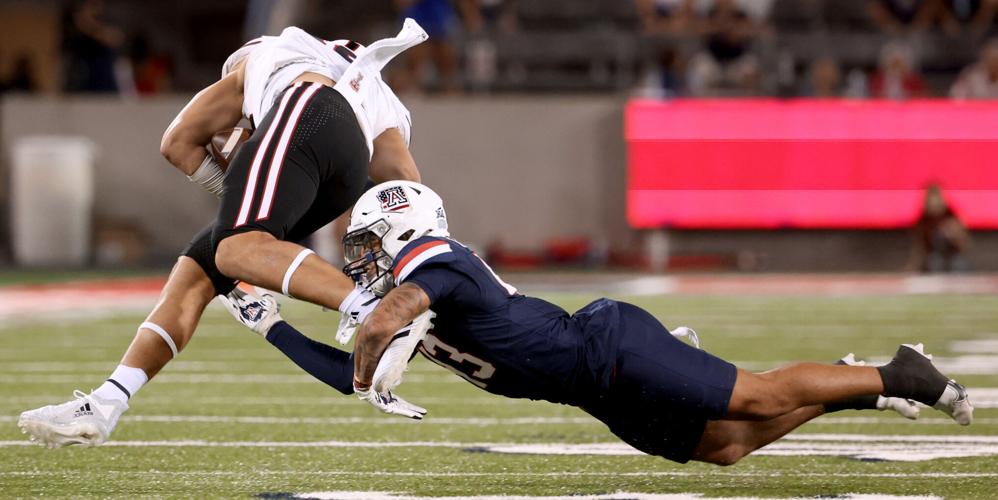The Arizona defense isn’t the same group that started the season.
Three pillars of that unit — linebacker Jacob Manu and defensive backs Gunner Maldonado and Treydan Stukes — are out for the year because of injuries. The Wildcats’ two 300-plus-pound defensive tackles, Isaiah Johnson and Chubba Ma’ae, have missed time. So has their top cornerback, Tacario Davis.

Defensive coordinator Duane Akina has dug deep into his reservoir of coaching knowledge to put a competitive product on the field every Saturday. It’s been hit-or-miss.
In this week’s “Cats Stats,” we’ll examine some of the issues that have plagued the defense of late and some of the changes Akina has been forced to make. He has used the analogy of the Apollo 13 mission, which is appropriate for this week’s “Space Game” at UCF but probably a stretch when it comes to patching together a defensive unit. Still, it’s been fascinating to watch it all unfold in real time.

Arizona defensive lineman Tre Smith (3) tries to fight out of the grip of Texas Tech offensive lineman Sheridan Wilson (72) in his effort to get to Texas Tech running back Tahj Brooks (28) on Oct. 5 at Arizona Stadium.
Not feeling the pressure
Arizona’s pass rush has been a nonfactor the past three weeks — losses to BYU, Colorado and West Virginia.
Sacks, or lack thereof, are the simplest way to illustrate that. The Wildcats averaged 2.75 sacks in the four-game stretch that began with Northern Arizona and ended with Texas Tech. They’ve had two — total — in the past three games.
If you know how we roll around here, we place greater value on pressures than sacks. Those numbers also have fallen off precipitously.
Arizona averaged 20.8 individual quarterback pressures in the first five games, according to Pro Football Focus. The Wildcats have 20 total pressures the past three games, an average of 6.7. Their season-long average is 15.5 per game, down from 18.1 last season.
Defensive end Tre Smith was leading the charge through the first four weeks, totaling 21 pressures. He has had only five since. Smith has been spotted with a walking boot during the pregame “Wildcat Walk,” so he’s probably not 100% healthy.
The overall drop-off in pressure is a product of attrition and strategy — the latter an adjustment to the former.
“Some coverage situations have forced us to maybe shift gears a little bit,” Akina said. “There’s probably been a little more three-man pass rush.”
When the secondary was fully operational, Akina could trust those players to execute their coverage assignments. Now, less experienced players such as redshirt-freshman safety Jack Luttrell are learning on the fly.
Akina blitzed West Virginia’s Nicco Marchiol less than any quarterback Arizona had faced this season — just four times in 29 dropbacks (13.8%), per PFF. Is there a correlation between blitz rate and pressure rate? Not necessarily.
UA defenders logged a season-high 30 pressures against NAU with a blitz rate of just 18.2%. They had 19 pressures apiece against Kansas State and Utah. Arizona blitzed KSU 16.7% of the time, Utah 43.2%.

West Virginia quarterback Nicco Marchiol (8) celebrates after throwing a touchdown pass against Arizona in the first half of their Oct. 26 matchup at Arizona Stadium in Tucson.
Arizona has blitzed (five or more rushers) on 26.6% of opponents’ dropbacks this season, per PFF. The Wildcats’ rate was 25.6% last year. Most of the defensive linemen responsible for generating those non-blitz pressures in 2023 are no longer in Tucson.
Getting off the field
This was a problem against West Virginia.
Between third and fourth down, the Mountaineers converted on 11 of 20 attempts (55%) — and one of the “unsuccessful” ones was a WVU kneel-down.
The previous week, Colorado converted 10 of 21 third- and fourth-down opportunities (47.6%). You’d like your stop rate to be closer to 40% than 50%.
A healthier, fresher UA defense held Utah to 0 for 4 on fourth downs on Sept. 28. West Virginia went 4 for 4 last week. A case could be made that those plays were the deciding factor in both games.
As mentioned above, Arizona hasn’t been as aggressive in those situations. Akina described it as “getting people off the field through coverage now more than pressure,” or at least trying to.

Arizona defensive coordinator Duane Akina celebrates with defensive back Owen Goss after the Wildcats made a fourth-down stand against NAU on Sept. 7. Akina’s injury-riddled defense has struggled in recent weeks.
“And there’s just a few things that have dictated that move for us,” he added.
Their names are Manu, Maldonado and Stukes.
Reduced rotation
Akina’s circle of trust is shrinking, and so is Arizona’s defensive rotation.
The Wildcats used only 18 players on defense vs. West Virginia, tying their season low (NAU). They used an average of 21 players over the previous three games.
Of those 18, 11 played at least 56 snaps (out of 67). The other seven played 16 or fewer.
Akina is trying give the players available to him assignments that they can execute. If they have less familiarity with certain scenarios — because they’ve never experienced them before on game days — he’s less apt to make those calls.
Johnson’s new role
No player has been impacted more by the injuries than redshirt junior Dalton Johnson.

Arizona’s Dalton Johnson (43) snares Texas Tech wide receiver Brady Boyd (13) after Boyd’s catch out wide in the third quarter of the teams’ Oct. 5 Big 12 matchup in Tucson.
Besides being unable to play with his buddies, Johnson has been forced to play a new position.
“Now he’s really our middle linebacker,” Akina said.
A strong safety by trade, Johnson played linebacker on 55 of 67 snaps vs. West Virginia, according to PFF. He basically played the same role the previous week vs. Colorado (49 of 71 snaps).
Johnson’s deployment vs. the Buffaloes was thought to be matchup-driven; they typically line up in four-receiver sets without a tight end. But Akina stuck with it vs. West Virginia — and seems likely to do so again vs. UCF in the interest of putting what he considers his best 11 players on the field.
Johnson is listed at 5-11, 202 pounds, considerably lighter than Manu (228). Johnson also often played “in the box” while at safety.
Johnson tied his career high with 13 tackles against West Virginia. But the Mountaineers rushed for 203 yards — the most by a UA opponent since Kansas State (235) on Sept. 13.
Mismatch vs. UCF?
Arizona is now set to face the top rushing team in the Big 12. UCF ranks first in the conference and fourth nationally with an average of 267.9 rushing yards per game.
Powerful senior RJ Harvey already has eclipsed 1,000 yards and has a league-high 13 touchdowns. If Jacurri Brown starts at quarterback, he poses an additional ground-game threat.
Can Arizona hold up with what is essentially a dime defense (six defensive backs) against a prolific, multifaceted rushing attack? That’ll be one of the determining factors Saturday in Orlando.
Akina did say that UCF’s scheme has “a lot of similarities” to West Virginia’s. That should help the Wildcats prepare. But they didn’t exactly fare well against the Mountaineers.
“You can’t reinvent the wheel every week,” Akina said.
That’s especially true in Arizona’s current predicament.








